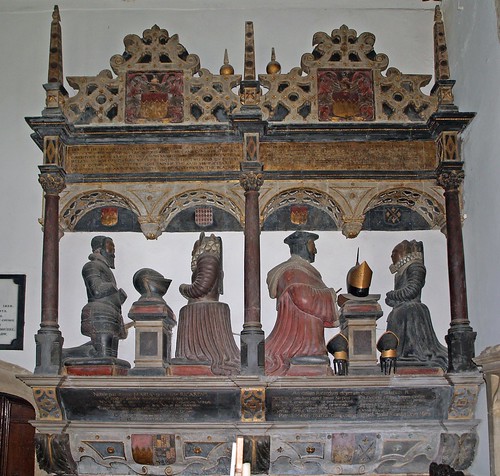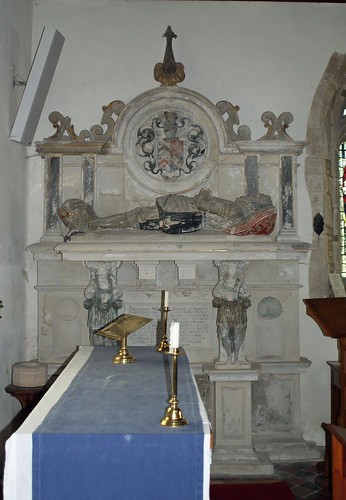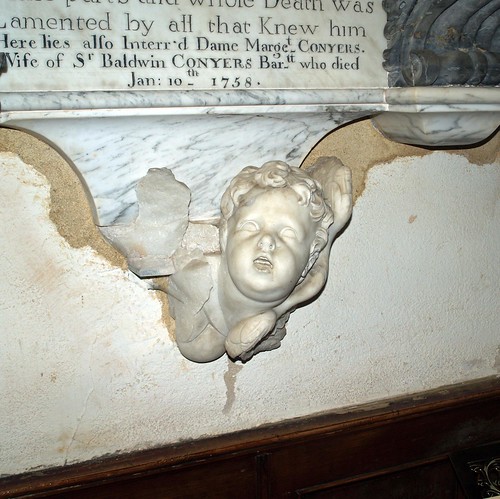ST ANDREW. The W tower is Perp and more ambitious than most, with its quatrefoil base frieze and its quatrefoil top frieze and its pinnacles. Set-back buttresses. Pairs of transomed two-light bell-openings. Earlier is the chancel, say early C14. One window has cusped Y-tracery, and the low-side window of two lights even a reticulation unit. Definitely Dec is the S aisle. Again reticulated tracery. The S doorway is something special, with its dainty foliage capitals and the many mouldings of the arch. The tower must be later than the S aisle. This is obvious by the aisle W window. Inside, the arcades (of five bays) are both older than anything outside. First come three bays on the S side (round piers and abaci), then the rest of the S arcade and the whole N arcade. Round piers and the abaci chamfered squares set diagonally. All arcade arches are double-chamfered. But the chancel arch and the tower arch are Perp. The N chapel dates from c.1455 and has a tomb recess with a panelled vault. - SCREEN. Under the tower arch. It consists of two parts, the lower panels from a C17 pulpit (with one inlaid panel), but the upper, once a bench-back, with an inscription to Olyver Leder and his wife and the date 1539. - COMMUNION RAIL. Late c 17, of strong, twisted balusters. - (STAINED GLASS. C16 and C17 heraldic glass from Gaynes Hall in the N aisle E window. GMCH) - BELL. One bell is by William Dawe; c 1400. - PAINTINGS. Two icons brought from Chanak (?) in Anatolia in 1923. One the Virgin, the other a saintly King. - PLATE. Cup, Paten on foot, and Almsdish, all 1751-2. - MONUMENTS. Upper part of a C13 monument to an abbot. Alwalton (rather than Purbeck) marble. The head in a pointed-cinquefoiled surround. The monument used to be in the garden of Gaynes Hall, and its provenance is unknown. It should be compared with the abbots’ monuments of Peterborough Cathedral. - Large stone monument to Sir James Dyer d. 1582, in judge’s robes, and his wife, and Sir Richard d. 1605 and wife. Two kneeling couples, husband facing wife across a prayer-desk (but Sir Richard has put his helmet on it). Three columns and pendant arches. Big strapwork on the top, and obelisks. - George Wauton d. 1606. Recumbent effigy, the slab on which he lies supported by two free-standing atlantes with short skirts. - Sir Baldwin Conyers d. 1731. A conservative composition for its date. An urn on a small sarcophagus in a shell-headed niche. Roman Doric columns and a pediment broken back in the centre. Two cherubs on it and two cherubs’ heads at the foot.
GREAT STAUGHTON. The little Kym stream flows by its old houses. Place House stands behind a grand old wall, with its tiled barns and 16th century timbers. Gaynes Hall is 17th century, with many beautiful doors and the remains of a medieval stone figure of an abbot in its garden; Staughton House, once the rectory manor and home of the Baldwins, is in its park of 500 acres. The great house Staughton Manor is no more; its double moat now encircles a farmhouse. It was the home of the Wautons, one of whom signed the death warrant of Charles Stuart and escaped vengeance by flying to Holland where he became a gardener. In the village is a 17th century cross with a sundial.
The massive church tower is 400 years old and has quaint faces keeping watch. Up in its belfry a man and a boy were once killed by lightning. A tablet in the tower records the event.
All our chief building centuries have given something to this splendid clerestorial church. The chancel is 13th century, the aisles and parapets and porch 14th, and the clerestory and chancel arch 15th. Men, women, angels, and grotesques hold up the roof of the nave, and looking down on the chancel is an angel with a chalice. A panelled recess in a chapel is enriched with 16th century carving. The 14th century font has traces of painting; it has been rescued from under the floor of the south aisle.
The oak screen, shutting off the belfry from the nave, is made up from panels of the old pulpit and the back of an old bench-end, the twisted balusters of the altar rails are 17th century, and the door, made by a 16th century carpenter, is still on its old hinges. It is studded with nails and hangs in a doorway twice as old as the door. Two other 400-year-old doors are still in their places.
There is an interesting group of monuments. That of Sir George Wauton, on which he lies in armour, looking very quaint on a high shelf supported by two men in short skirts, was paid for by Sir Oliver Cromwell, the great Oliver’s uncle. Oliver’s sister Margaret had married into the family. Two knights of Elizabeth’s day kneel with their wives at prayer desks on a huge tomb flanked by Corinthian columns: James and Richard Dyer. James was Lord Chief Justice, and lived at Place House; he is in Judge's robes and on his prayer desk is a helmet, a rather curious thing. The funeral helmet of Sir James Beverley, and a pair of iron gauntlets, are on his 17th century altar tomb; he lived at Gaynes Hall.
There is a monument with a trophy of arms to an 18th century Governor of Jamaica who sleeps here with his son, and one more pleasing with a cherub watching over Christopher and Mary Conyers, a brother and a sister who died in infancy 200 years ago, children of Sir John Conyers who lived at Staughton House after the Baldwins.
There is a fine ring of six bells in the tower. One of them is medieval and at least 100 years older than the tower itself, and above the chancel arch a sanctus bell still hangs in its cot, one of the few left in the country. The silver communion plate was given to the church by Christopher Walters in 1750 in memory of his wife.
A small brass has a tribute to Richard Walter who sailed round the world with Lord Anson and saw life on every continent. He died in 1785, and here he sleeps, his long voyage over. Born early in the 18th century, the son of a London merchant, he graduated at Cambridge. In 1740 he resigned a fellowship to become chaplain of the Centurion, the flagship of the little fleet with which Lord Anson set out to do battle with Spain, and in the end to sail round the world and bring home the laurels of victory, £500,000 in treasure, and rich additions to knowledge.
Walter was a puny, sickly little man, but he had a hero’s courage, and for 27 months he endured battle, storm, and tempest in which five ships were lost and men died as in a plague. The little chaplain was more than spiritual comforter in those days; he helped to work the ship, and shared the hard lot of the fighters and the sailors. After more than two years his frail physique could endure no more, and on arriving at Macao Anson sent him home. He was appointed chaplain of Portsmouth Dockyard and held the post until his death, forty years later. Anson returned at the end of about four years and Richard Walter, taking over the great seaman’s journals, wrote the splendid story of his voyage, picturing life in every continent - the well-known Voyage Round the World.
The massive church tower is 400 years old and has quaint faces keeping watch. Up in its belfry a man and a boy were once killed by lightning. A tablet in the tower records the event.
All our chief building centuries have given something to this splendid clerestorial church. The chancel is 13th century, the aisles and parapets and porch 14th, and the clerestory and chancel arch 15th. Men, women, angels, and grotesques hold up the roof of the nave, and looking down on the chancel is an angel with a chalice. A panelled recess in a chapel is enriched with 16th century carving. The 14th century font has traces of painting; it has been rescued from under the floor of the south aisle.
The oak screen, shutting off the belfry from the nave, is made up from panels of the old pulpit and the back of an old bench-end, the twisted balusters of the altar rails are 17th century, and the door, made by a 16th century carpenter, is still on its old hinges. It is studded with nails and hangs in a doorway twice as old as the door. Two other 400-year-old doors are still in their places.
There is an interesting group of monuments. That of Sir George Wauton, on which he lies in armour, looking very quaint on a high shelf supported by two men in short skirts, was paid for by Sir Oliver Cromwell, the great Oliver’s uncle. Oliver’s sister Margaret had married into the family. Two knights of Elizabeth’s day kneel with their wives at prayer desks on a huge tomb flanked by Corinthian columns: James and Richard Dyer. James was Lord Chief Justice, and lived at Place House; he is in Judge's robes and on his prayer desk is a helmet, a rather curious thing. The funeral helmet of Sir James Beverley, and a pair of iron gauntlets, are on his 17th century altar tomb; he lived at Gaynes Hall.
There is a monument with a trophy of arms to an 18th century Governor of Jamaica who sleeps here with his son, and one more pleasing with a cherub watching over Christopher and Mary Conyers, a brother and a sister who died in infancy 200 years ago, children of Sir John Conyers who lived at Staughton House after the Baldwins.
There is a fine ring of six bells in the tower. One of them is medieval and at least 100 years older than the tower itself, and above the chancel arch a sanctus bell still hangs in its cot, one of the few left in the country. The silver communion plate was given to the church by Christopher Walters in 1750 in memory of his wife.
A small brass has a tribute to Richard Walter who sailed round the world with Lord Anson and saw life on every continent. He died in 1785, and here he sleeps, his long voyage over. Born early in the 18th century, the son of a London merchant, he graduated at Cambridge. In 1740 he resigned a fellowship to become chaplain of the Centurion, the flagship of the little fleet with which Lord Anson set out to do battle with Spain, and in the end to sail round the world and bring home the laurels of victory, £500,000 in treasure, and rich additions to knowledge.
Walter was a puny, sickly little man, but he had a hero’s courage, and for 27 months he endured battle, storm, and tempest in which five ships were lost and men died as in a plague. The little chaplain was more than spiritual comforter in those days; he helped to work the ship, and shared the hard lot of the fighters and the sailors. After more than two years his frail physique could endure no more, and on arriving at Macao Anson sent him home. He was appointed chaplain of Portsmouth Dockyard and held the post until his death, forty years later. Anson returned at the end of about four years and Richard Walter, taking over the great seaman’s journals, wrote the splendid story of his voyage, picturing life in every continent - the well-known Voyage Round the World.



No comments:
Post a Comment